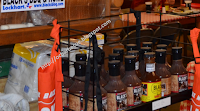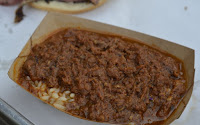This is part 2 of the post Texas Barbecue Myths. For Texas Barbecue Myths – Part 1 – Click Here.
Myth #5 – Texas-style Barbecue must be Cooked Low and Slow
 |
The glorious barbecue smoker at Smitty's Barbecue
that greets you when you come through the back door.
|
Myth #6 – Brisket is the Hardest Cut to Barbecue
People who believe that brisket is the toughest cut of meat
to barbecue have never tried to barbecue venison, beef round (a Virginia thing),
beef shoulder (also a Virginia thing) or a whole hog (also a Virginia thing). The famous Texas barbecue
cook Walter Jetton didn’t believe that brisket was the hardest meat to
barbecue. In fact, he used to recommend the cut to people without experience
cooking barbecue because, according to Jetton, “it’s a self-basting cut.” (from
Legends of Texas Barbecue Cookbook)
 |
| Brisket being served at Kreuz Market. |
Not only is brisket not the hardest meat to barbecue, it’s
also not the tastiest. Though a well barbecued brisket is delicious (think John
Lewis Barbecue in Charleston), so is well barbecued pork, chicken, round roast
and chuck. I think that many Texas barbecue restaurant owners, deep down
inside, know that. That’s why so many are now resorting to cooking prime grade
brisket. At least one famous Texas barbecue restaurant, Killen’s Barbecue in
Houston, cooks Wagyu brisket that they sell for $30.00 per pound while claiming
that they make no profit from it at all. If you have to resort to the highest
price grade of meat for barbecue (where the tradition is to turn low quality
cuts into a delicacy) to make the barbecue delicious, perhaps that cut of meat
isn’t so great tasting to begin with.
Myth #7 – Texas Barbecue is the Best Barbecue in the World
How many times have you read a review of barbecue in Texas
and it included some kind of outrageous statement such as, “Texas barbecue is
the best in the world!” When I read things like that I think one of two things:
either the writer is actually a salesperson masquerading as a writer or the
person writing the review hasn’t eaten much barbecue in their life. The truth
is, you can find very tasty and exceptional barbecue in Texas. However, you can
find very tasty and exceptional barbecue in Kansas City, Virginia, South
Carolina, North Carolina, Georgia, Alabama, Kentucky and a slew of other
places. To claim that Texas barbecue is the best in the world is a far-fetched
fantasy. To be correct, I’d say that some Texas barbecue is among the best in
the world. But, I’d say the same about South Carolina and Virginia. That’s a
fact-based statement that recognizes the succulent barbecue in those states
while leaving room for other places like Texas to also have delicious barbecue.
It’s truth, not salesmanship or myth.
The Truth About Texas Barbecue. What’s Really Unique about It?
The truth about Texas barbecue is that there are very few
things about it that are unique. Like some Californians, some Texans cook
“barbecue” by burying it in holes after wrapping it in burlap. Like
Californians, some Texans also claim to be able to barbecue steaks (west Texas
barbecue). Texans barbecue brisket much like people in Kansas City barbecue it.
The barbecue sauces in Texas aren’t much different from the sauces you find all
around the South. Serving barbecue with only a vinegary hot sauce on the side
as they do at Kreuz isn’t confined to Texas. It’s done in North Carolina, too
and is probably more of a “North Carolina thing” than a “Texas thing.” Rubs
made with only salt and pepper are old hat in Virginia. King’s Barbecue in
Petersburg has been in business for 70 years. They serve delicious Virginia-style
barbecued beef (not briskets) that they season with a rub made with only salt
and pepper. Texans cook their barbecue using white oak (called post oak in
Texas and in Virginia for as long as I can remember) just like many southerners.
There is even a district in my county in Virginia named Post Oak. My Mother's family is from an area named White Oak.
It’s also a centuries old tradition in the South to eat barbecue with your fingers. That’s not just a “Texas thing” and was a “Virginia thing” and a “North Carolina thing” for well over 200 years before it ever became a “Texas thing.” Barbecue served on butcher paper has also been done outside of Texas for a long time. Barbecue restaurants and stands in Kansas City have been serving barbecue on or wrapped in butcher paper at least as far back as the late 19th century when the Father of Kansas City barbecue Henry Perry opened his barbecue stand.
It’s also a centuries old tradition in the South to eat barbecue with your fingers. That’s not just a “Texas thing” and was a “Virginia thing” and a “North Carolina thing” for well over 200 years before it ever became a “Texas thing.” Barbecue served on butcher paper has also been done outside of Texas for a long time. Barbecue restaurants and stands in Kansas City have been serving barbecue on or wrapped in butcher paper at least as far back as the late 19th century when the Father of Kansas City barbecue Henry Perry opened his barbecue stand.
Texas lacks its own barbecue stew. Virginia has Brunswick
stew. South Carolina has barbecue hash. Texas lacks a defining barbecue sauce
flavor profile. Eastern North Carolina has its undiluted vinegar with salt and
peppers. Virginia has its spiced sauces of the central region and the tangy
sauces with a hint of mustard in the southside. Texas lacks a true brisket
burnt ends tradition like that found in Kansas City. When I visit Texas, I miss
barbecue sandwiches with coleslaw on them. The lack of these things is not
necessarily a bad thing; it’s a Texas thing.
One of the most unique things about Texas barbecue is a
popular magazine that devotes reams of paper, gallons of ink and uncountable
numbers of electrons producing lavish and glowing praise on barbecue found in
the state or at least in one part of Texas. Texas is a huge state but it only
has four barbecue styles found in four regions: Eastern Texas with its
southern-style barbecue, Central Texas with its butcher shop-style barbecue, South
Texas with its Mexican-style barbacoa, and the cowboy ‘que of West Texas.
However, all of the styles of barbecue found in Texas are mostly ignored by the
“press” except central Texas-style barbecue. One wonders why there is a
noticeable lack of pride in the other styles. I have some ideas about it but
they are for another post.
 |
| Pork "steaks" at Snow's Barbecue. |
Another unique feature that you can find in some Texas
barbecue restaurants is the barbecue pit with an open fire at the end. The
first time I walked through the backdoor at Smitty’s Barbecue in Lockhart, I
was amazed, thrilled and mildly shocked to see an open fire at my feet situated
at the end of a barbecue pit with no fence, walls or other safety barrier to
prevent someone from stumbling into it. I don’t know of any other state that
would allow such a thing due to safety regulations. Even so, to me, the pits at
Smitty’s barbecue are nothing less than national treasures and shrines to
barbecue history. That’s a true Texas barbecue thing.
I’m all for enjoying Texas-style barbecue. When it’s done right,
it is delicious. However, I refuse to close my eyes and blindly accept the
Texas barbecue myths that are so blatantly spread nowadays by slick writers and
over-enthusiastic TV hosts. As they say, "Everything is bigger in Texas" and that includes their barbecue myths.
Texas Barbecue Myths – Part 1 – Click here.
























